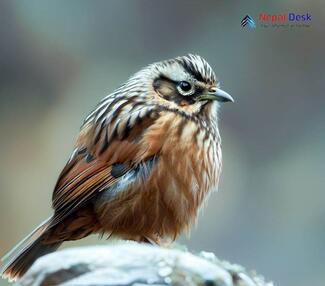The Altai Accentor (Prunella himalayana) is a small, sparrow-like bird native to the high-altitude mountain regions of Central Asia. It has a short, thick bill and a long, rounded tail. Its brownish-gray body has dark streaks on the back, distinctive white eyebrow stripes, dark wings with white wing bars, and paler underparts. Both male and female Alta Accentors have similar appearances, but males may display brighter colors during the breeding season. Now after basic info, let us explore the various details of this tiny creature:
Unique Behaviors and Habitat Preferences
This unique bird uses its wings to balance itself while perching on rocks and cliffs. Its flight behavior is typically short and low, lasting only a few seconds and covering a short distance. The Altai Accentor does not migrate long distances; instead, it moves to lower elevations in winter.
The mountainous regions of Central Asia, including parts of China, Mongolia, Russia, Kazakhstan, Kyrgyzstan, and the high-altitude areas of Nepal's Himalayas (Annapurna Conservation Area and Sagarmatha National Park), serve as its natural habitat.
Ecological Role and Diet
As an insectivorous species, the Altai Accentor plays a vital role in controlling insect populations within its alpine ecosystem. Its diet consists primarily of insects, spiders, and other small invertebrates. During winter months when insects are scarce, it may feed on seeds.
Social Behavior and Reproduction
The Altai Accentor is a solitary bird with little known about its breeding behavior. It is thought to form monogamous pairs during the breeding season. Males may perform courtship displays to attract mates, while females construct cup-shaped nests from grass and vegetation, typically found in rock crevices or on cliff ledges.
Best Time for Birdwatching
To observe the Altai Accentor in its natural habitat, visit Nepal between March-May and September-November. Birdwatchers have better chances of spotting this species in rocky terrain or near cliff ledges. Listen for its distinct call, consisting of short, high-pitched notes.
Conservation Status
The Altai Accentor is classified as a species of least concern on the IUCN Red List, meaning it is not currently threatened with extinction. However, it may still face challenges due to habitat loss and other factors.




